2013 FORD FIESTA child seat
[x] Cancel search: child seatPage 1 of 341

Introduction 8
Child Safety 16
Child seats...........................................18
Child seat positioning...................................18
Booster seats.........................................20
Installing child safety seats...............................22
Child safety locks......................................31
Safety Belts 32
Fastening the safety belts................................34
Safetybeltwarninglightandindicatorchime..................37
Safety belt-minder.....................................38
Child restraint and safety belt maintenance...................40
Personal Safety System 41
Supplementary Restraints System 42
Driver and passenger airbags.............................44
Knee airbag..........................................45
Front passenger sensing system...........................46
Side airbags..........................................50
Side curtain airbags....................................51
Crash sensors and airbag indicator.........................53
Airbag disposal........................................54
Keys and Remote Control 55
General information on radio frequencies.....................55
Remote control.......................................56
Keys...............................................56
Replacing a lost key or remote control.......................60
Table of Contents1
2013 Fiesta(fie)
Owners Guide gf, 1st Printing
USA(fus)
Page 9 of 341

Symbol Description Symbol Description Symbol Description
Brake fluid –
non
petroleum
baseBrake systemCabin air
filter
Check fuel
capChild Safety
Door Lock
and UnlockChild seat
lower anchor
Child seat
tether anchorCruise
controlDo not open
when hot
Engine air
filterEngine
coolantEngine
coolant
temperature
Engine oilExplosive gasFan warning
Fasten safety
beltFront airbagFront fog
lamps
Fuel pump
resetFuse
compartmentHazard
warning
flasher
Heated rear
windowInterior
luggage
compartment
releaseJack
Lighting
controlLow tire
pressure
warningMaintain
correct fluid
level
Panic alarmParking aid
systemParking
brake system
Introduction9
2013 Fiesta(fie)
Owners Guide gf, 1st Printing
USA(fus)
Page 14 of 341
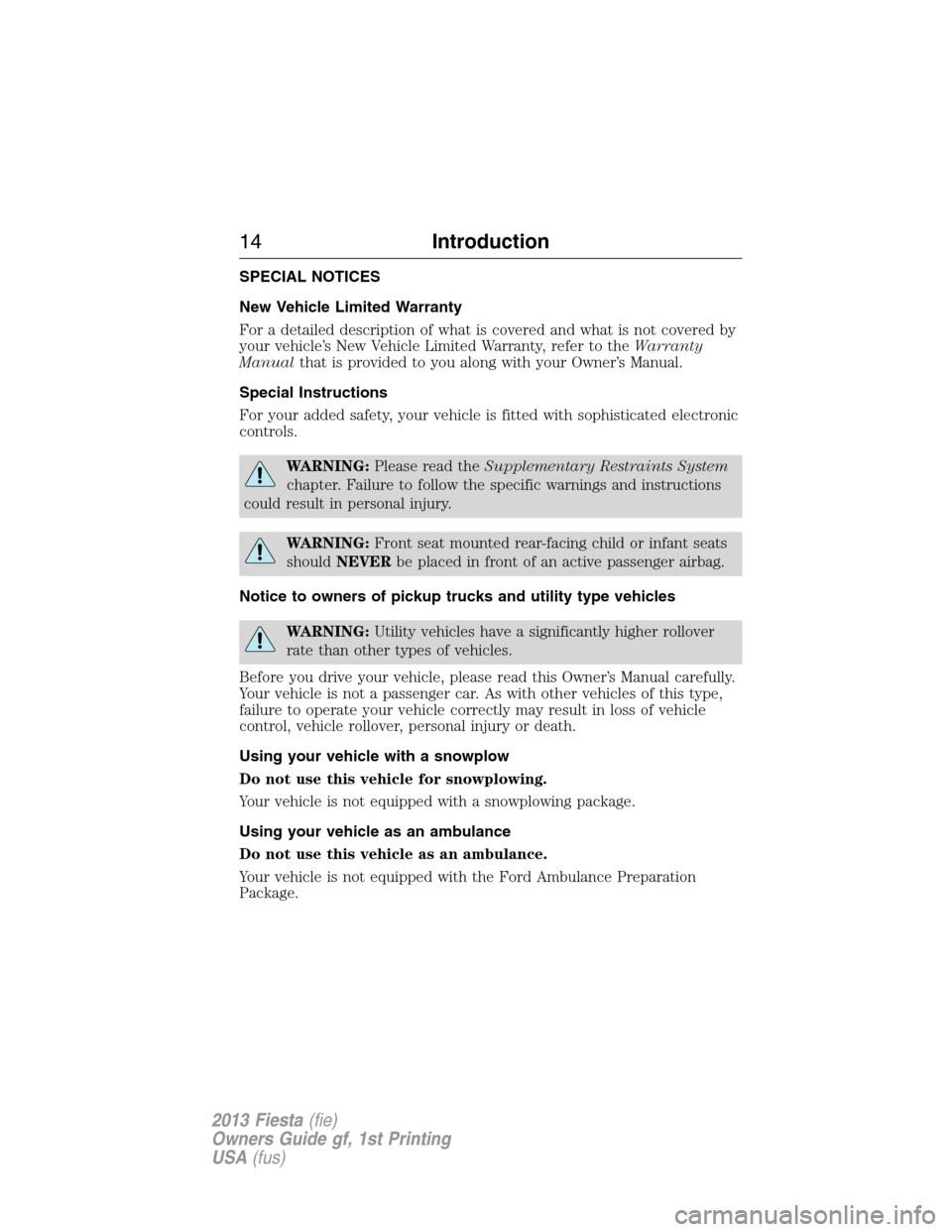
SPECIAL NOTICES
New Vehicle Limited Warranty
For a detailed description of what is covered and what is not covered by
your vehicle’s New Vehicle Limited Warranty, refer to theWarranty
Manualthat is provided to you along with your Owner’s Manual.
Special Instructions
For your added safety, your vehicle is fitted with sophisticated electronic
controls.
WARNING:Please read theSupplementary Restraints System
chapter. Failure to follow the specific warnings and instructions
could result in personal injury.
WARNING:Front seat mounted rear-facing child or infant seats
shouldNEVERbe placed in front of an active passenger airbag.
Notice to owners of pickup trucks and utility type vehicles
WARNING:Utility vehicles have a significantly higher rollover
rate than other types of vehicles.
Before you drive your vehicle, please read this Owner’s Manual carefully.
Your vehicle is not a passenger car. As with other vehicles of this type,
failure to operate your vehicle correctly may result in loss of vehicle
control, vehicle rollover, personal injury or death.
Using your vehicle with a snowplow
Do not use this vehicle for snowplowing.
Your vehicle is not equipped with a snowplowing package.
Using your vehicle as an ambulance
Do not use this vehicle as an ambulance.
Your vehicle is not equipped with the Ford Ambulance Preparation
Package.
14Introduction
2013 Fiesta(fie)
Owners Guide gf, 1st Printing
USA(fus)
Page 16 of 341
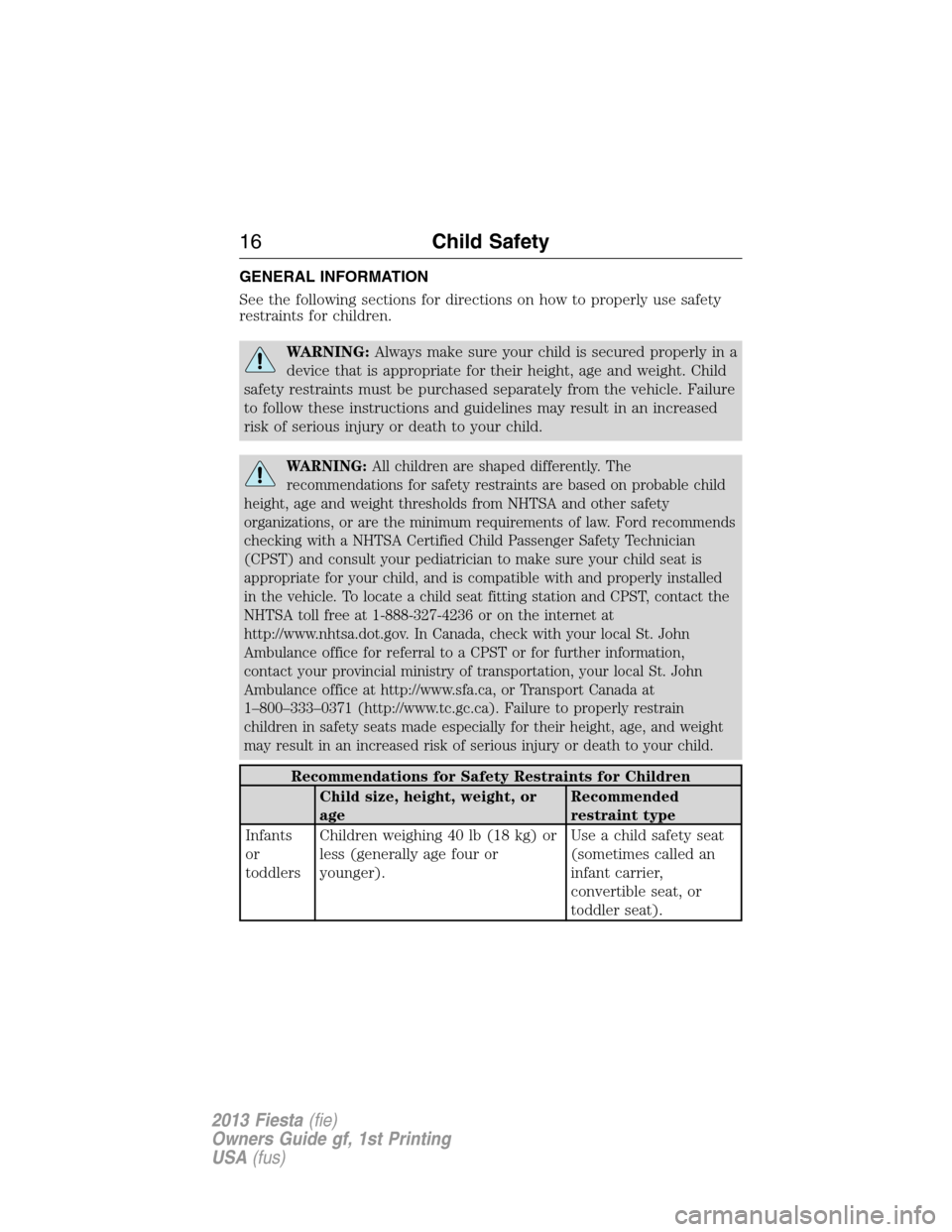
GENERAL INFORMATION
See the following sections for directions on how to properly use safety
restraints for children.
WARNING:Always make sure your child is secured properly in a
device that is appropriate for their height, age and weight. Child
safety restraints must be purchased separately from the vehicle. Failure
to follow these instructions and guidelines may result in an increased
risk of serious injury or death to your child.
WARNING:All children are shaped differently. The
recommendations for safety restraints are based on probable child
height, age and weight thresholds from NHTSA and other safety
organizations, or are the minimum requirements of law. Ford recommends
checking with a NHTSA Certified Child Passenger Safety Technician
(CPST) and consult your pediatrician to make sure your child seat is
appropriate for your child, and is compatible with and properly installed
in the vehicle. To locate a child seat fitting station and CPST, contact the
NHTSA toll free at 1-888-327-4236 or on the internet at
http://www.nhtsa.dot.gov. In Canada, check with your local St. John
Ambulance office for referral to a CPST or for further information,
contact your provincial ministry of transportation, your local St. John
Ambulance office at http://www.sfa.ca, or Transport Canada at
1–800–333–0371 (http://www.tc.gc.ca). Failure to properly restrain
children in safety seats made especially for their height, age, and weight
may result in an increased risk of serious injury or death to your child.
Recommendations for Safety Restraints for Children
Child size, height, weight, or
ageRecommended
restraint type
Infants
or
toddlersChildren weighing 40 lb (18 kg) or
less (generally age four or
younger).Use a child safety seat
(sometimes called an
infant carrier,
convertible seat, or
toddler seat).
16Child Safety
2013 Fiesta(fie)
Owners Guide gf, 1st Printing
USA(fus)
Page 17 of 341
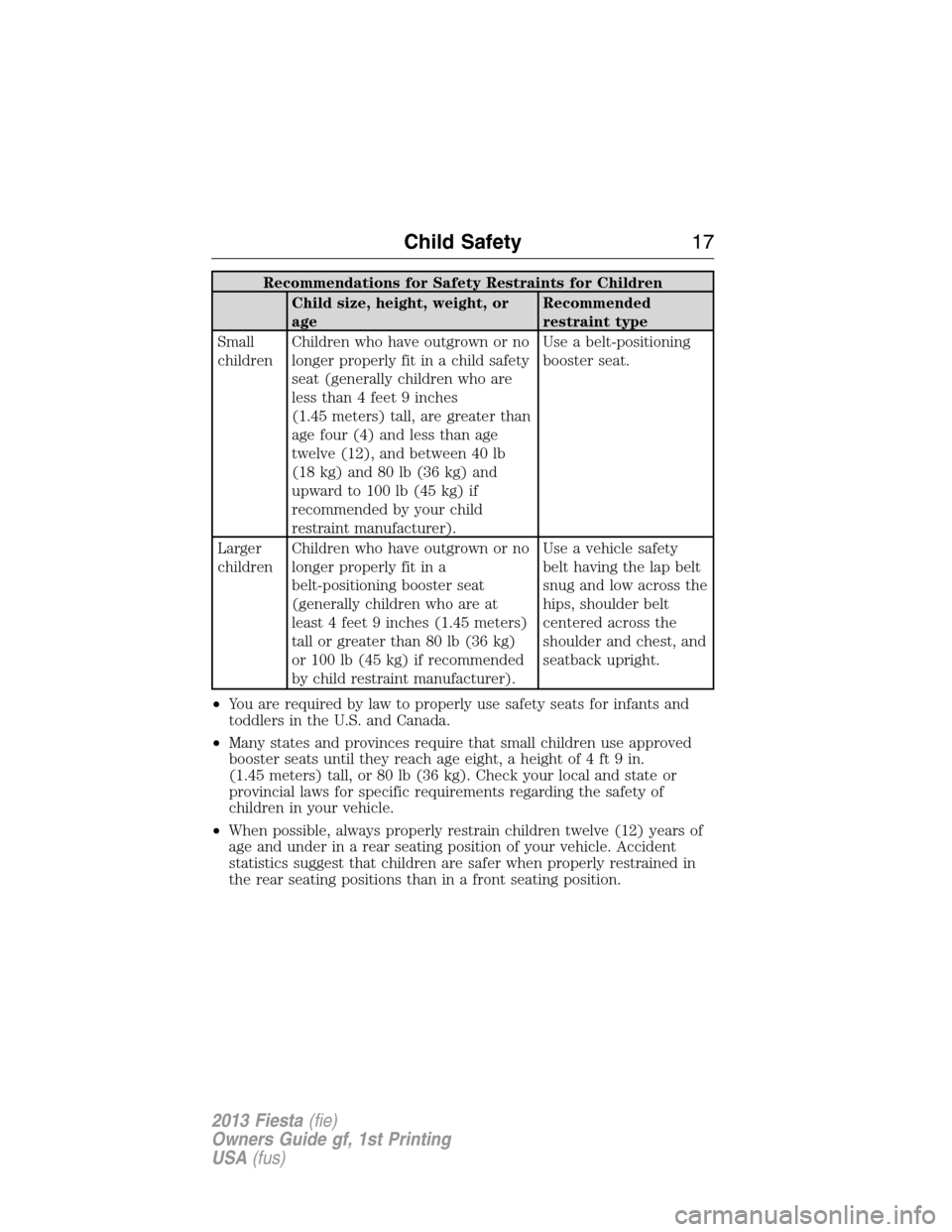
Recommendations for Safety Restraints for Children
Child size, height, weight, or
ageRecommended
restraint type
Small
childrenChildren who have outgrown or no
longer properly fit in a child safety
seat (generally children who are
less than 4 feet 9 inches
(1.45 meters) tall, are greater than
age four (4) and less than age
twelve (12), and between 40 lb
(18 kg) and 80 lb (36 kg) and
upward to 100 lb (45 kg) if
recommended by your child
restraint manufacturer).Use a belt-positioning
booster seat.
Larger
childrenChildren who have outgrown or no
longer properly fit in a
belt-positioning booster seat
(generally children who are at
least 4 feet 9 inches (1.45 meters)
tall or greater than 80 lb (36 kg)
or 100 lb (45 kg) if recommended
by child restraint manufacturer).Use a vehicle safety
belt having the lap belt
snug and low across the
hips, shoulder belt
centered across the
shoulder and chest, and
seatback upright.
•You are required by law to properly use safety seats for infants and
toddlers in the U.S. and Canada.
•Many states and provinces require that small children use approved
booster seats until they reach age eight, a height of 4 ft 9 in.
(1.45 meters) tall, or 80 lb (36 kg). Check your local and state or
provincial laws for specific requirements regarding the safety of
children in your vehicle.
•When possible, always properly restrain children twelve (12) years of
age and under in a rear seating position of your vehicle. Accident
statistics suggest that children are safer when properly restrained in
the rear seating positions than in a front seating position.
Child Safety17
2013 Fiesta(fie)
Owners Guide gf, 1st Printing
USA(fus)
Page 18 of 341
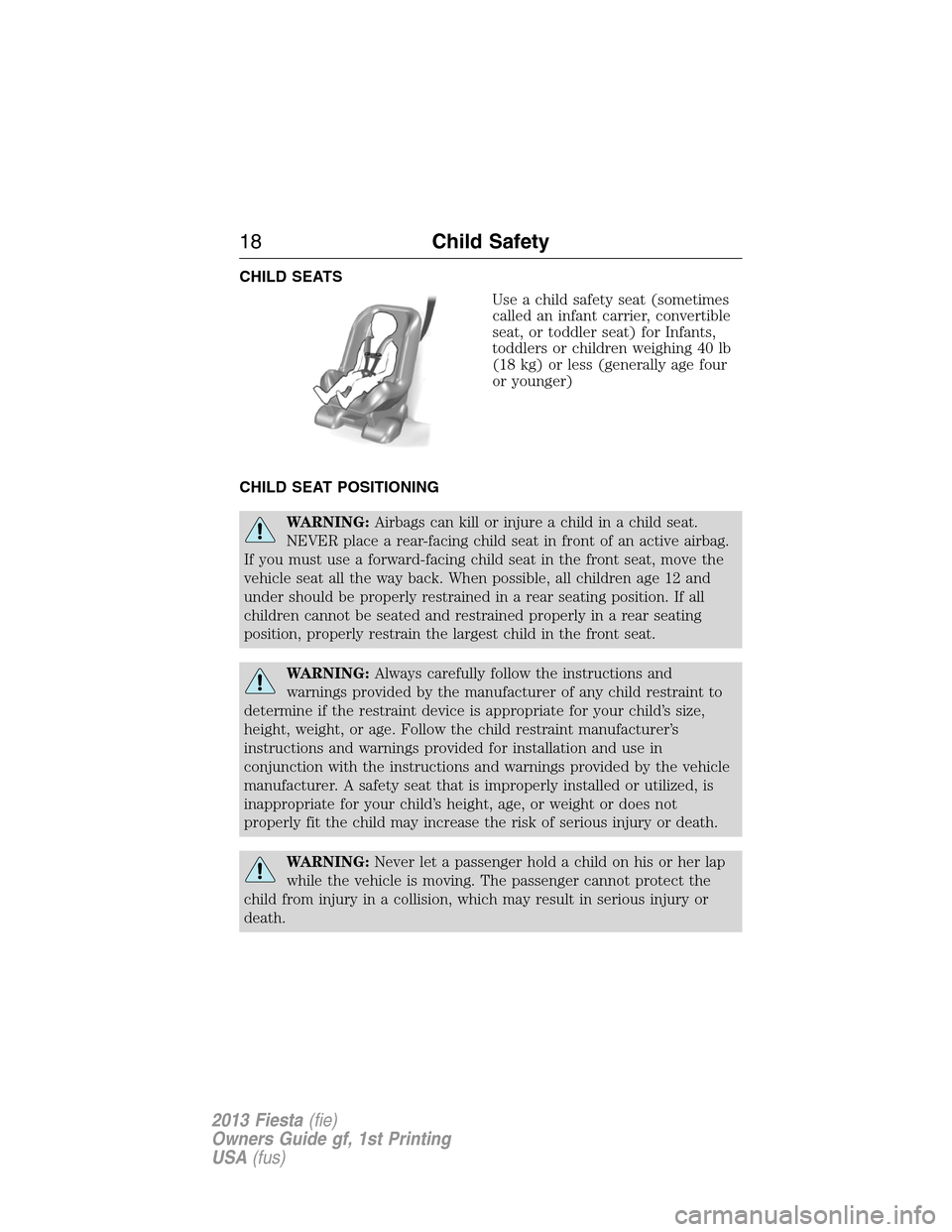
CHILD SEATS
Use a child safety seat (sometimes
called an infant carrier, convertible
seat, or toddler seat) for Infants,
toddlers or children weighing 40 lb
(18 kg) or less (generally age four
or younger)
CHILD SEAT POSITIONING
WARNING:Airbags can kill or injure a child in a child seat.
NEVER place a rear-facing child seat in front of an active airbag.
If you must use a forward-facing child seat in the front seat, move the
vehicle seat all the way back. When possible, all children age 12 and
under should be properly restrained in a rear seating position. If all
children cannot be seated and restrained properly in a rear seating
position, properly restrain the largest child in the front seat.
WARNING:Always carefully follow the instructions and
warnings provided by the manufacturer of any child restraint to
determine if the restraint device is appropriate for your child’s size,
height, weight, or age. Follow the child restraint manufacturer’s
instructions and warnings provided for installation and use in
conjunction with the instructions and warnings provided by the vehicle
manufacturer. A safety seat that is improperly installed or utilized, is
inappropriate for your child’s height, age, or weight or does not
properly fit the child may increase the risk of serious injury or death.
WARNING:Never let a passenger hold a child on his or her lap
while the vehicle is moving. The passenger cannot protect the
child from injury in a collision, which may result in serious injury or
death.
18Child Safety
2013 Fiesta(fie)
Owners Guide gf, 1st Printing
USA(fus)
Page 19 of 341
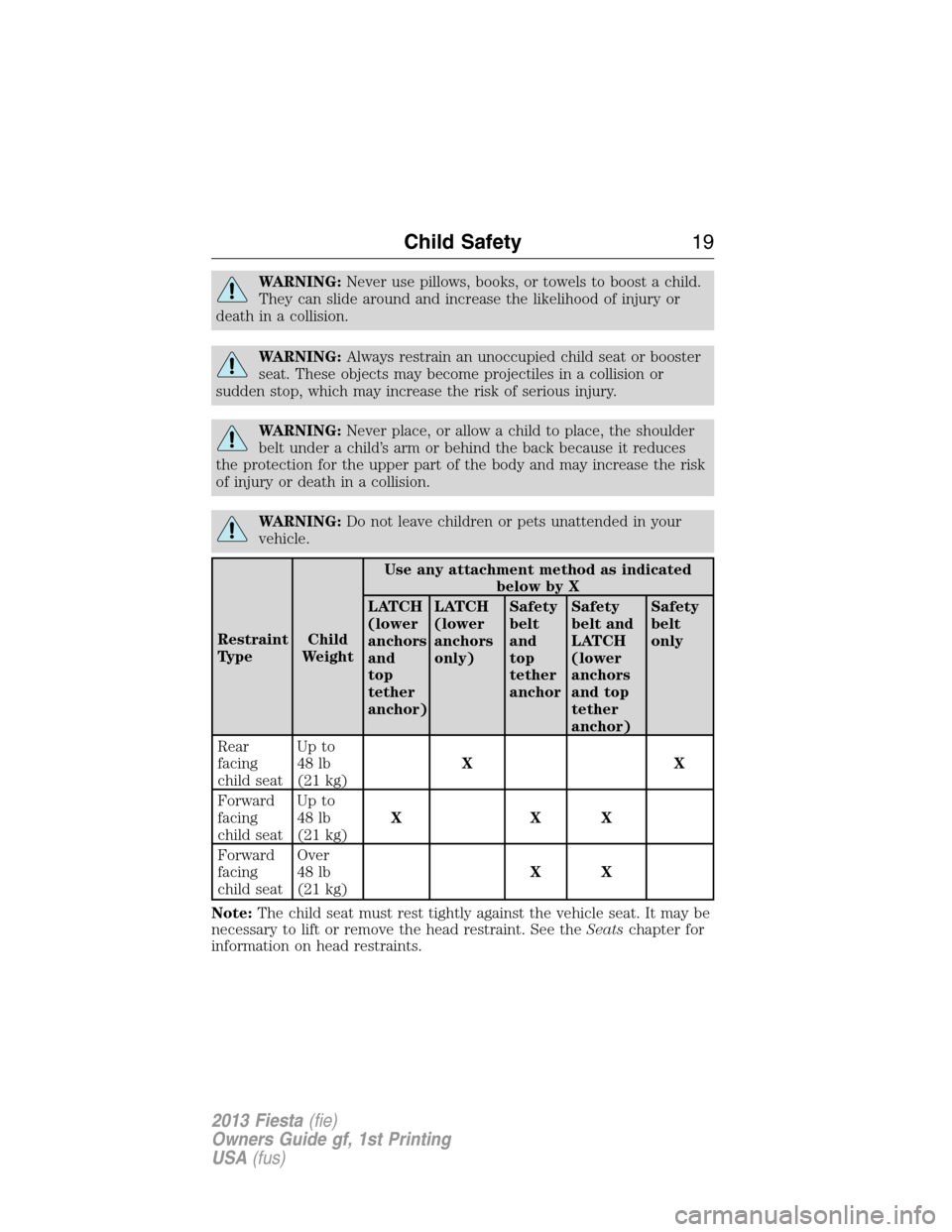
WARNING:Never use pillows, books, or towels to boost a child.
They can slide around and increase the likelihood of injury or
death in a collision.
WARNING:Always restrain an unoccupied child seat or booster
seat. These objects may become projectiles in a collision or
sudden stop, which may increase the risk of serious injury.
WARNING:Never place, or allow a child to place, the shoulder
belt under a child’s arm or behind the back because it reduces
the protection for the upper part of the body and may increase the risk
of injury or death in a collision.
WARNING:Do not leave children or pets unattended in your
vehicle.
Restraint
TypeChild
WeightUse any attachment method as indicated
below by X
LATCH
(lower
anchors
and
top
tether
anchor)LATCH
(lower
anchors
only)Safety
belt
and
top
tether
anchorSafety
belt and
LATCH
(lower
anchors
and top
tether
anchor)Safety
belt
only
Rear
facing
child seatUp to
48 lb
(21 kg)XX
Forward
facing
child seatUp to
48 lb
(21 kg)XXX
Forward
facing
child seatOver
48 lb
(21 kg)XX
Note:The child seat must rest tightly against the vehicle seat. It may be
necessary to lift or remove the head restraint. See theSeatschapter for
information on head restraints.
Child Safety19
2013 Fiesta(fie)
Owners Guide gf, 1st Printing
USA(fus)
Page 20 of 341
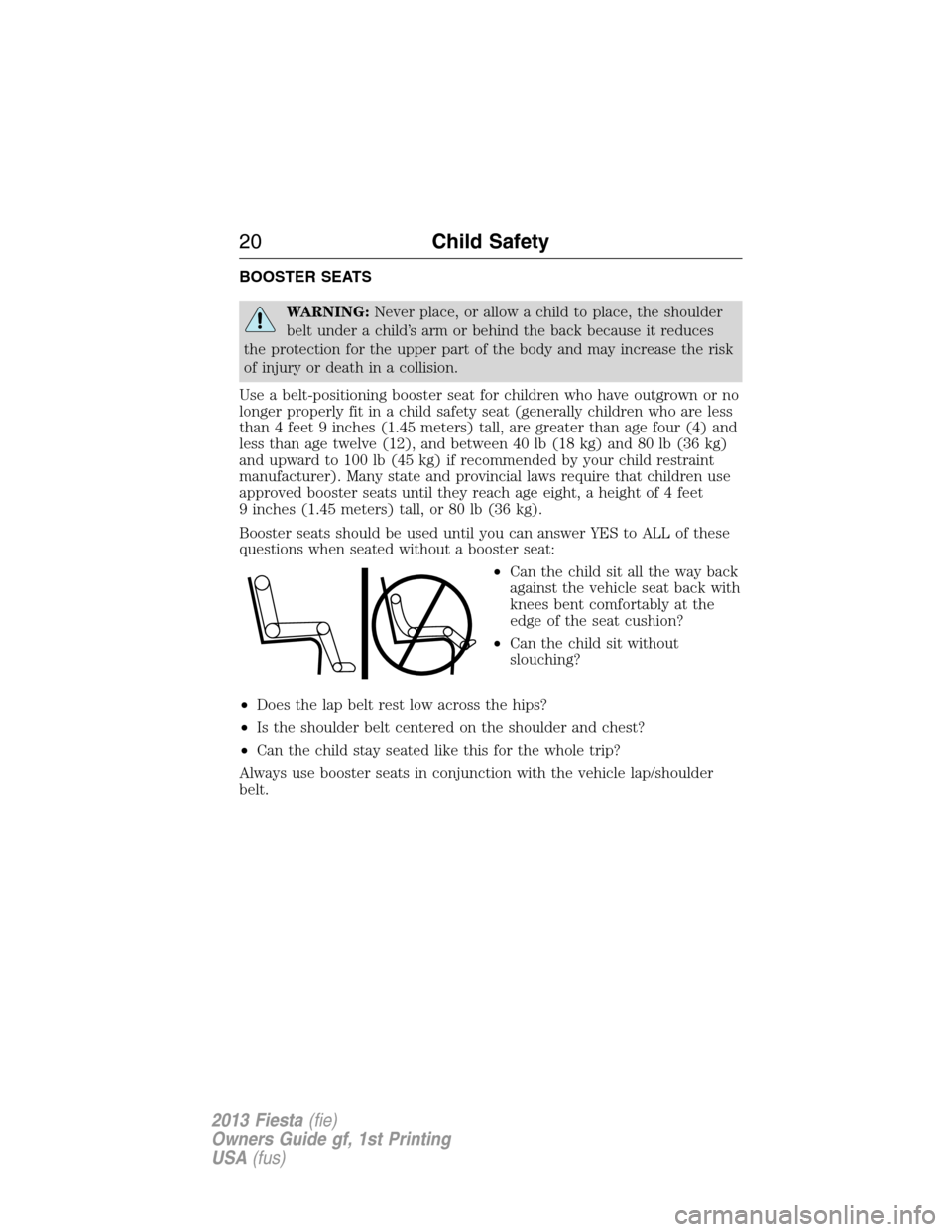
BOOSTER SEATS
WARNING:Never place, or allow a child to place, the shoulder
belt under a child’s arm or behind the back because it reduces
the protection for the upper part of the body and may increase the risk
of injury or death in a collision.
Use a belt-positioning booster seat for children who have outgrown or no
longer properly fit in a child safety seat (generally children who are less
than 4 feet 9 inches (1.45 meters) tall, are greater than age four (4) and
less than age twelve (12), and between 40 lb (18 kg) and 80 lb (36 kg)
and upward to 100 lb (45 kg) if recommended by your child restraint
manufacturer). Many state and provincial laws require that children use
approved booster seats until they reach age eight, a height of 4 feet
9 inches (1.45 meters) tall, or 80 lb (36 kg).
Booster seats should be used until you can answer YES to ALL of these
questions when seated without a booster seat:
•Can the child sit all the way back
against the vehicle seat back with
knees bent comfortably at the
edge of the seat cushion?
•Can the child sit without
slouching?
•Does the lap belt rest low across the hips?
•Is the shoulder belt centered on the shoulder and chest?
•Can the child stay seated like this for the whole trip?
Always use booster seats in conjunction with the vehicle lap/shoulder
belt.
20Child Safety
2013 Fiesta(fie)
Owners Guide gf, 1st Printing
USA(fus)